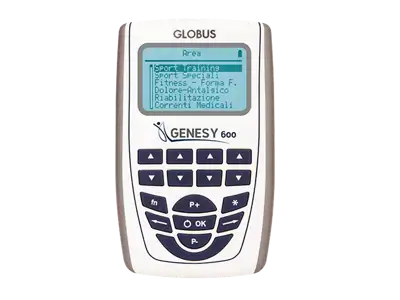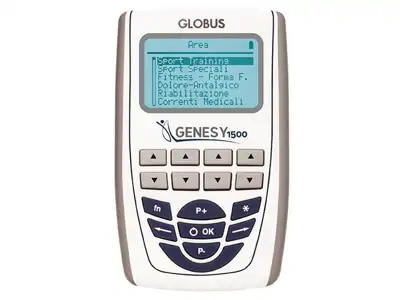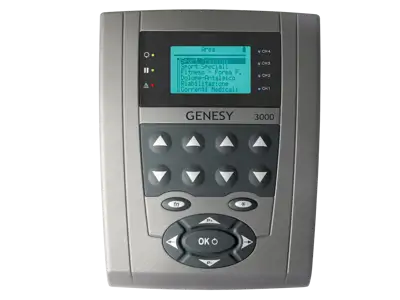Denervated
What is selective stimulation current therapy?
Selective stimulation current therapy is a form of electrotherapy. It can be used to treat so-called denervated muscles.
It is used to treat several forms of peripheral paralysis: peroneal paralysis, facial nerve paralysis, spinal hernia, nerve injury after spinal fracture, nerve injury during spinal surgery, etc.
Watch out! Some therapists also mistakenly treat paralysis due to stroke with selective stimulation. However, selective stimulation current treatment is not good for stroke patients because it causes an increase in muscle stiffness (in jargon: increases spasticity). The motor nerve of the muscle affected by strokes is healthy (the problem is at the brain junction). Therefore, spastic paralysis should not be treated with selective stimulation, but with "smooth", biphasic square-wave muscle stimulation (and low frequency)!
Selective stimulation is selective in that it affects denervated muscles, but not healthy innervated muscles!
Selective stimulation current treatment involves applying a milliampere (mA) electrical pulse through an electrode (which can be self-adhesive, metal or rubber) to the skin, which contracts. The shape of the pulse can be triangular, trapezoidal or square wave. You can control the frequency, intensity and duration of the contraction, how much it grips the muscle bundle, at what speed and how often it occurs.
The treatment can be focused on a specific muscle or group of muscles, so that it only has an effect on those muscles.
"Normally", muscle contraction is triggered by an electrical signal from your brain. In stimulus current treatment, the muscle receives similar artificial impulses.
In both cases, it contracts by exactly the same mechanism, the same metabolic processes take place, and it tires in exactly the same way.
Treating a muscle that has lost its motor nerve
This is the application of selective stimulus current. The chance of recovery of denervated muscle is increased many times over if you receive selective stimulation current treatment on a daily basis!
Those who do not receive regular stimulation current treatment improve little or significantly more slowly. With stimulation, there is a real chance for nerve regeneration and "re-growth".
You need to know that nerve pathways regenerate extremely slowly. Even under optimal conditions, with continuous stimulation, they grow at a maximum of 1 mm per day. If you have a nerve injury during a spinal operation, for example, the nerve can grow from the spine to the toes by 70-80 cm, which means it takes at least 7-800 days to fully regenerate! That's 3 years or more!
And during that time, you need to stimulate it every day, persistently! Without this, the muscle that has lost its motor nerve will atrophy, degenerating into a gelatinous mass in about two years, from which there is no way back. Stimulation can keep the muscle tissue alive until the nerve reaches the muscle again.
The very important "ability" of stimulation is to "retrain" the neuromuscular (nerve-muscle) connection. According to some studies, the brain and the motor nerve cell that runs from the brain to the muscles need at least 10,000 (ten thousand) repetitions to relearn how to perform a movement. The re-learning of muscles that do not work after paralysis can be greatly accelerated by stimulation.
I should mention here that not all muscle stimulator devices are suitable for stimulating peripheral nerve injury or, in other technical terms, denervated (lost innervation) muscle. It is not worth "rushing" the paralysed patient with the paresis device bought at Lild, or even with something much more serious! You need a more sophisticated device for this.
While a healthy muscle with a motor nerve can be treated with a so-called biphasic square wave, a denervated muscle does not respond to this. However, it can be made to contract with a long-duration pulse, called a triangular or trapezoidal pulse!
For peripheral paralysis, treatment has a "nice arc". They usually start with a triangular pulse, then as the nerve renegades, they slowly move to a trapezoidal and then finally a quadrangular pulse.
Stimulation of muscles with healthy innervation
If the nerve fibre running to the muscle is preserved (even preserved in a stroke), then there is no need for selective stimulation. A biphasic square wave for muscle stimulation is appropriate for this purpose.
An important difference is also the duration of the pulse. While 200-900 milliseconds (i.e. almost a second) are used to treat denervated muscle, a thousandth of a second (microsecond), i.e. a much shorter pulse duration, is used for healthy muscle.



